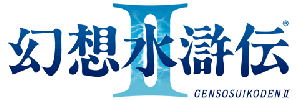
 |
|
First, the good news: Suikoden II is nearly identical to the first Suikoden. Now for the bad news: Suikoden II is nearly identical to the first Suikoden. In its similitary to Suikoden I, however, Suikoden II is actually unique: it not only carries on its predecessor's storyline, but refines the gameplay into something superior but still distinctly Suikoden. The story itself picks up three years after Suikoden, where war is brewing in the north between the Highland Kingdom and the Jowston City-State Alliance. As expected, fighting breaks out, some bad guys try to take over the world, and the hero is called in to save the world without ever actually talking.
Though the story itself mostly apes Suikoden's plot, the return of numerous beloved characters and locations makes the trip worthwhile. For once, we get to see what happened to the cast of a previous game in the series, and nearly every unanswered question from Suikoden is explained here: Who is the girl that Clive is pursuing, and why does he continue his relentless chase? Did Flik and Viktor escape the collapsing Gregminster Palace? Where did Yuber vanish to? Of course, none of this will mean a thing to gamers not familiar with the Suikoden milieu; the first title is a prerequisite to appreciating the second. (In fact, saves from the end of Suikoden can be imported into Suikoden II to boost the returning characters's stats and enable one special secret.) Suikoden II's gameplay also evolves naturally from Suikoden I's. Once again, you try to gather all 108 Stars of Destiny and assemble them in your slowly-developing fortress. Most of the Stars are fighters or magicians that can be added to your six-member combat team, while others run shops, build statues, and change the colors of your menu screen. Suikoden II throws a few twists into the formula by forcing you to choose which characters to recruit at certain points; you won't be able to obtain every possible party member in a single run through the game.
Each party member is now more customizable than before, thanks to an improved version of the Rune System. Up to three Runes, generally found in shops and chests, can be embedded in a character; each Rune brings either improved statistics, new combat abilities (stealing money, for example), or magic. In a new twist, some of the combat-oriented Runes can only be used by characters with a specific type of weapon -- the attack-boosting Titan Rune, for example, can only be used by characters with two-handed swords. Magic works in the same way as it did in Suikoden: each magical Rune has four spells, and each character has four sets of MP that correspond to those four spells. Additionally, many spells can be found in the form of consumable spell scrolls. The controversial army battles also return, expanded but not necessarily improved. In the original Suikoden, large-scale battles were nothing more than a glorified rock-paper-scissors game: Charge beat Bows, Bows beat Magic, and Magic beat Charge. The same hierarchy is retained in Suikoden II, but you're now capable of moving your units about the battle map as in a strategy RPG. Each unit consists of three characters of your choosing; the characters contribute their own attack and defense power to the unit's, as well as any special abilities such as flight or first aid. Proper selection and balancing is essential. Your goal is generally to eradicate all the enemy units (two successful attacks destroy any unit), but sometimes you're given other goals, such as defending a city or capturing any enemy leader. Unfortunately, nearly every army battle drags forever, as both your units and the enemies' miss their target with alarming frequency -- far too frequently, a team of apparently blind and deaf cavalrymen rushes right by a group of defenseless archers. It's unfortunate that the army battles are so tedious, because the concepts behind them were promising -- properly balanced, the army battles could have been one of Suikoden II's star attractions.
All these changes add up to a far deeper experience than the short and laughably easy Suikoden I. While Suikoden II isn't the most challenging game in existence, and still suffers from a lack of bosses, it offers significantly more gameplay. Some of the dungeons now actually extend beyond four screens; a few even contains puzzles. Numerous hidden characters and three different endings that are actually different add replay value, and several mini-games -- including the now-obligatory music game -- provide an entertaining diversion from the main story. Unfortunately, Suikoden II is one of lacking Suikoden I's greatest features: the music. A flat and lifeless score replaces Suikoden I's diverse and catchy melodies; even the sound samples seem to be inferior. Most of the tracks are so drab that you'll forget them as soon as they end; they're certainly not worth buying the soundtrack for. To be fair, the soundtrack is actually passable in its own right, but still it's a huge disappointment when compared to Suikoden's -- indeed, the only memorable tracks are those remixed from Suikoden I's score. RPG fans have constantly clamored for a true sequel that carries on both the gameplay and storyline of its predecessor -- it's about time a developer took the hints. Konami deserves commendation for not only attempting to continue the Suikoden story, but for succeeding with flying colors. Mediocre music aside, Suikoden II improves on Suikoden in nearly every area: story, replay value, gameplay, and especially box art. Review by Fritz Fraundorf, GIA. |
|
|||||||||||||||||||||||||||||||||||||||||||||||




